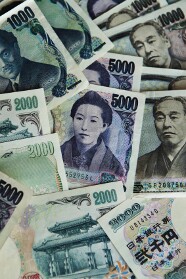The Japanese yen gained for the second week as risk aversion sentiment prevailed on the Forex market, while the Bank of Japan refrained from easing its monetary policy despite its promises.
The BoJ left its interest rates and asset-purchase program unchanged for the second time at its meeting on April 10. Such decision left frustrated those traders who expected the Bank to intervene. Still the central bank signaled that it’s going to “pursue powerful monetary easing”, thus limiting the gains of the yen.
News from other parts of the world was also supportive for the Japanese currency. Rising unemployment claims in the United States, growing borrowing costs in Spain and slowing China’s economy made traders to buy safer currency of Japan, avoiding risk.
The yen ended flat on Monday as most markets were closed, though fluctuations were noticeable. The currency fell on Tuesday as traders digested the report that that employment growth in the USA was much slower than anticipated. The yen was falling next two days as investors demonstrated some risk appetite, but China’s growth of GDP that was slower than expected returned demand for Japan’s currency and it jumped on Friday.
USD/JPY fell from 81.51 to 80.90 this week, touching 80.56, the lowest rate since February 29. EUR/JPY was down from 106.76 to 105.81, while the weekly low of 105.44 was the lowest since February 22. GBP/JPY declined from 129.45 to 128.20, reaching during the week 127.86 — the lowest since March 8.
If you have any questions, comments or opinions regarding the Japanese Yen,
feel free to post them using the commentary form below.
